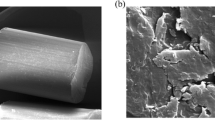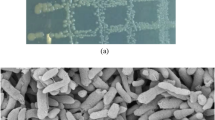Abstract
The response of Pseudomonas putida F1 to process fluctuations and operational failures during toluene biodegradation was evaluated in a chemostat suspended growth bioreactor. The ability of P. putida F1 to rapidly increase its specific toluene degradation capacity resulted in no significant variation in process removal efficiency when toluene load was increased from 188 to 341 g m−3 h−1. Likewise, bacterial activity rapidly reached steady state performance (in less than 1.5 h after the restoration of steady state operational conditions) following an 8 h process shutdown, or after episodes of toluene or mineral nutrients deprivation. Process performance was however highly sensitive to pH, as pH levels below 4.5 dramatically inhibited bacterial activity, decreasing severely process robustness and inducing a cycle of periodic process collapses and recoveries. This pH mediated deterioration of bacterial activity was confirmed by further respirometric tests, which revealed a 50–60% reduction in the O2 consumption rate during the degradation of both toluene and 3-methyl catechol when pH decreased from 5.05 to 4.55. Finally, process robustness was quantified according to methods previously described in literature.





Similar content being viewed by others
References
Baquerizo G, Maestre JP, Gamisans X, Gabriel D, Lafuente J (2007) Study of NH3 removal by Gas-Phase Biofiltration: effects of shock loads and watering rate on biofilter performance. In: Proceedings of the II international congress on biotechniques for air pollution control, A Coruña, Spain, 3–5 October 2007
Barona A, Elias A, Arias R, Cano R, González R (2004) Biofilter response to gradual and sudden variations in operating conditions. Biochem Eng J 22:25–31
Bordel S, Muñoz R, Díaz LF, Villaverde S (2007) New insights on toluene biodegradation by Pseudomonas putida F1: influence of pollutant concentration and excreted metabolites. Appl Microbiol Biotechnol 74:857–866
Boudreau NG, Daugulis AJ (2006) Transient performance of two-phase partitioning bioreactors treating a toluene contaminated gas stream. Biotechnol Bioeng 94:448–457
Diaz LF, Muñoz R, Bordel S, Villaverde S (2008) Toluene biodegradation by Pseudomonas putida F1: targeting culture stability in long term operation. Biodegradation 19(2):197–202
Elena SF, Lenski RE (2003) Microbial genetics: evolution experiments with microorganisms: the dynamics and genetic bases of adaptation. Nat Rev Genet 4:457–469
Halecky M, Paca J, Gerrard AM, Soccol CR (2007) Styrene degradation in perlite biofilter: the overall performance characteristics and dynamic response. In: Proceedings of the II international congress on biotechniques for air pollution control, A Coruña, Spain, 3–5 October 2007
Jenkins RO, Heald SC (1996) Stability of toluene oxidation by Pseudomonas putida under nutrient deprivation. Appl Microbiol Biotechnol 46:388–392
Jung IG, Park OH (2005) Enhancement of cometabolic biodegradation of trichloroethylene (TCE) gas in biofiltration. J Biosci Bioeng 100:657–661
Kennes C, Thalasso F (1998) Waste gas biotreatment technology. J Chem Technol Biotechnol 72:303–319
Kraakman NJR (2003) Robustness of a full-scale biological system treating industrial CS2 emissions. Environ Prog 22:79–85
Kraakman NJR (2005) Biotrickling and bioscrubbers applications to control odor and air pollutants: developments, implementation issues and case studies. In: Shareefdeen Z, Singh A (eds) Biotechnology for odour and air pollution control. Springer-Verlag, Heidelberg
Maestre JP, Gamisans X, Gabriel D, Lafuente J (2007) Fungal biofilters for toluene biofiltration: evaluation of the performance with tour parking materials under different operating conditions. Chemosphere 67:684–692
Metris A, Gerrard AM, Cumming RH, Weigner P, Paca J (2001) Modelling shock loadings and starvation in the biofiltration of toluene and xylene. J Chem Technol Biotechnol 76:565–572
Moe WM, Qi B (2004) Performance of a fungal biofilter treating gas-phase solvent mixtures during intermittent loading. Water Res 38:2259–2268
Morales M, Velázquez E, Jan J, Revah S, González U, Razo-Flores E (2004) Methyl tert-butyl ether biodegradation by microbial consortia obtained from soil samples of gasoline-polluted sites in Mexico. Biotechnol Lett 26:269–275
Nielsen DR, Sak KN, Mclellan PJ, Daugulis AJ (2006) Benzene vapor treatment using a two-phase partitioning bioscrubbers: an improved steady-state protocol to enhance long-term operation. Bioprocess Biosyst Eng 29:229–240
Parales RE, Haddock JD (2004) Biocatalytic degradation of pollutants. Curr Opin Biotechnol 15:374–379
Roch F, Alexander M (1997) Inability of bacteria to degrade low concentrations of toluene in water. Environ Toxicol Chem 16:1377–1383
Roy S, Gendron J, Delhomenie MC, Bibeau L, Heitz M, Brzezinski R (2003) Pseudomonas putida as the dominant toluene-degrading bacterial species during air decontamination by Biofiltration. Appl Microbiol Biotechnol 61:366–373
Van Groenestijn JW, Hesselink PGM (1993) Biotechniques for air pollution control. Biodegradation 4:283–301
Williams TO, Miller FC (1992) Biofilters and facility operations. Biocycle 31:75–79
Acknowledgement
This research was supported by the Spanish Ministry of Education and Science (PPQ2006-08230 and RYC-2007-01667).
Author information
Authors and Affiliations
Corresponding author
Rights and permissions
About this article
Cite this article
Muñoz, R., Díaz, L.F., Bordel, S. et al. Response of Pseudomonas putida F1 cultures to fluctuating toluene loads and operational failures in suspended growth bioreactors. Biodegradation 19, 897–908 (2008). https://doi.org/10.1007/s10532-008-9191-5
Received:
Accepted:
Published:
Issue Date:
DOI: https://doi.org/10.1007/s10532-008-9191-5




